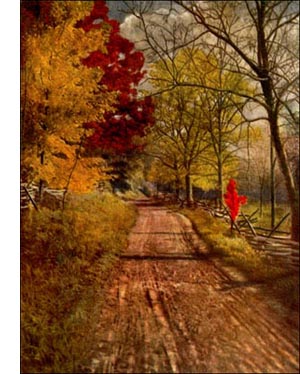English or Persian Walnut Tree
 The English or Persian Walnut (Juglans regia, Linn.)-a royal tree and nut indeed!-is the walnut of classical literature, beloved of gods and men. From the hillsides of Persia and the regions far East this species was carried into southern Europe, whence it spread to England and finally to America. The tree is grown for lumber, for ornament, and for its fruit in the countries that feel the warm breath of the Japan Current and the Gulf Stream. The best nuts come from France and Italy. In England the nuts are generally pickled green, as the season is too short to insure their ripening. The English walnut, like the English elm, came to us via England, and got its name en route. Neither species is a native of that island. Importations of the nuts came to us also through England until recent years.
The English or Persian Walnut (Juglans regia, Linn.)-a royal tree and nut indeed!-is the walnut of classical literature, beloved of gods and men. From the hillsides of Persia and the regions far East this species was carried into southern Europe, whence it spread to England and finally to America. The tree is grown for lumber, for ornament, and for its fruit in the countries that feel the warm breath of the Japan Current and the Gulf Stream. The best nuts come from France and Italy. In England the nuts are generally pickled green, as the season is too short to insure their ripening. The English walnut, like the English elm, came to us via England, and got its name en route. Neither species is a native of that island. Importations of the nuts came to us also through England until recent years.The wealth of Europe has been increased by the enforced planting of walnut trees. In the seventeenth century in certain countries there was a law requiring a young man to produce a certificate of his having planted a certain number of walnut trees before he could obtain permission to marry! The names of this tree are full of tradition and poetry. The English had the nuts before they introduced the trees. "Walnut" means "a nut brought from a foreign country." "Juglans" is a contraction of Jovis glans, "the acorn of Jove"-for so the Greeks and Romans esteemed it. To extend its culture through allied countries was a work that rulers busied themselves about. Nux regia was the growers' name for the new tree, "because these nuts were brought to them by kings."
Through centuries of cultivation, many improved varieties of these Persian walnuts have arisen. Parkinson describes in 1640 a kind of "French wallnuts, which are the greatest of any, within whose shell are often put a paire of fine gloves neatly foulded up together." Another variety he knew "whose shell is so tender that it may easily be broken between one's fingers, and the nut itself is very sweete."
The culture of J. regia in southern California is highly specialised and very profitable. Irrigation and tillage are practised in these orchards. Frost and walnut blight are the nut-growers' chief enemies-unless the brokers who control prices may be listed as a third. The nut crop of 1901 in four counties was about 6,000 tons, worth more than a million dollars. The tree grows in the Southern States, and has proved hardy even in Massachusetts, but it is not cultivated commercially outside of California.
Walnut lumber (of J. regia) has had a variable and interesting history in Europe. The brown heart wood, always beautiful, often waved and watered in lovely patterns and shadings, yet suffered long in comparison with oak, as it had not the strength and durability of the latter, and its greyish sap wood was commonly "subject to the worm"-liable to become worm eaten. The best lumber came from Italy, the next best from the Black Sea regions, next from France, and the poorest grew in England.
In the early part of the eighteenth century a craving for walnut furniture struck the fashionable world. Oak became second in popularity. Then came a cold winter which killed the walnut trees. The Dutch Government bought the dead trees and cornered the market for a time. France prohibited the exportation of walnut; then mahogany began to be imported from tropical America and became the popular wood for fine furniture.
In the turmoil of international wars, each country wanted walnut for gun stocks. I n 1806 France used 12,000 trees. The English Government is said to have paid before the battle of Waterloo 600 pounds for a single walnut tree! In the height of the walnut vogue, cabinetmakers paid as high as 60 pound per ton for roots and burs, which were sawed very thin and used for veneering pianos and other elegant furniture. No wood excels this curly walnut in beauty.
In later years the importation of black walnut from America relieved the stress in the lumber trade. This tree grows well in Europe, and is an important species in the government forests of various countries. It has doubled in price in the past fifty years, and American walnut is now in greater demand abroad than the native species.